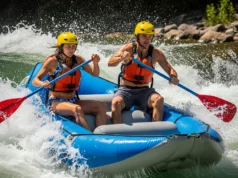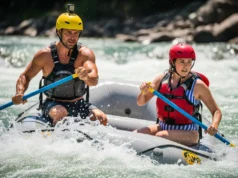In this article
Your raft gliding silently across a powerful current, achieving precise lateral movement toward a safe eddy as if guided by an invisible hand. Other boats are swept downstream, fighting the river, but you are dancing with it. This is the art of raft ferrying—the single most important skill in raft maneuvering for controlling your path on the water with minimal downstream drift. This guide will deconstruct that art into a science, giving you the pro-level techniques and the critical Ferry Angle Decision Matrix to turn the river’s energy into your tool for effective river navigation.
We’ll start by unpacking the physics, understanding how an angled raft hull acts like a wing to generate force from the river. From there, we’ll master the execution for the three essential river moves: the Forward Ferry, the Back Ferry, and the powerful Downstream Ferry. You’ll gain access to a unique framework that tells you when and why to use a specific ferry angle for any number of river scenarios. And most importantly, you’ll learn the golden safety rule: the non-negotiable technique of boat tilt to avoid catching an upstream edge—the most common cause of a wrap or flip.
Why Does a Raft Move Sideways? Unpacking the Physics of Ferrying
To truly master ferrying, you have to move beyond just following steps and start to feel the forces at play. This fundamental skill begins by understanding why a multi-ton heavy oar boat can slide across a powerful current. It isn’t magic; it’s hydrodynamic lift.
How does the river’s current create sideways force?
When you set your raft’s orientation to the current vector, it stops being a passive object and transforms into a hydrodynamic foil, behaving much like a wing in the air or a sail in the wind. Instead of the water simply pushing the raft downstream, the angled hull intercepts and redirects that moving mass of water. According to Newton’s Third Law, this redirection generates a powerful reactive force that propels the raft laterally. This is the lift that makes the ferrying technique possible.
This effect is further enhanced by a principle known as the Coanda effect, where a fluid jet “sticks” to a convex surface. As the river flows along the curved tube of your raft, it maximizes the momentum exchange, creating more efficient sideways thrust. The relationship between current speed and this force is exponential; a scientific analysis of reaction ferries shows that doubling the river’s speed actually quadruples the potential force generated by the hull. This is why in slow water, you must generate your own forward momentum, but in swift water, your primary job shifts to precise angle control.
With the core principle of lift established, let’s break down the interacting forces that determine your raft’s actual path across the river.
What Are the Core Ferrying Techniques for a Raft?
Understanding the “why” is foundational. Now we get to the “how.” These are the essential boat maneuvers in any guide’s toolkit, each with its own purpose, strengths, and applications for both paddle rafts and oar rigs.
How do you perform a Forward Ferry (Upstream Ferry)?
The forward ferry, also known as an Upstream Ferry or Ferry Glide, is your go-to move for crossing open stretches of water. It involves lateral movement across the current with the raft’s bow angled upstream, typically around 45°, while maintaining a net speed that is slightly slower than the main current itself.
The maneuver begins in the calm of an eddy. Before you cross the eddy line—a move often called a peel-out—you must set the boat up correctly. Establish your upstream angle and use your paddle calls to build sufficient forward momentum. The most critical phase is the transition. As your bow hits the faster water, the current differential will try to spin you. To counter this, the guide must use a powerful corrective stroke, like a draw stroke or stern draw, to maintain a good ferry angle. At the exact same moment, the entire crew must execute a mandatory boat tilt: lean to lower the downstream edge into the water. This lifts the upstream tube, allowing the powerful current to flow under the hull.
Once established, the crew maintains steady paddling. Your job as the captain is to make micro-adjustments with a rudder or pry stroke. In a paddle raft, your paddlers provide the power while you steer. In an oar rig, you use your oars for both. This technique is detailed in many a Rafting Course Manual, like the one from Frostburg State University, and is ideal for an efficient eddy out.
Pro-Tip: During any ferry, your eyes determine your line. Don’t stare at the water in front of you. Pick a landmark on the opposite bank—a specific tree or rock—and keep your focus locked on it. Your brain and body will subconsciously make the micro-corrections needed to move toward that target.
How do you execute a Back Ferry (Stern-First Ferry)?
A back ferry is the art of controlled retreat and precision maneuvering. It involves moving laterally with the raft’s stern angled upstream, while the crew paddles or rows backward using a reverse stroke. This slows the raft’s downstream momentum to less than the current, giving you more time to achieve precise river positioning and avoid obstacles like rocks or holes. This technique offers ultimate control and visibility, as you are facing downstream.
For an oar rig, this is its most powerful application. The rower points the stern toward the destination, angles the stern upstream, and pulls on the oars to generate backward momentum. In a paddle raft, the guide uses a pry or draw to set the stern angle, then calls for a “back paddle.”
The strategic advantage is immense. It is the preferred technique to set up for a rapid, navigate technical sections, and negotiate sharp bends where you need to move with deliberation.
How do you use a Downstream Ferry (The Power Move)?
The downstream ferry is an advanced technique used to move laterally by traveling faster than the current. This is the power move for high-volume rivers where a strong eddy line or large wave can stop a slower-moving raft. The most common application is in an oar rig, where the rower turns to face upstream and pulls powerfully. This accelerates the raft, and while moving faster than the water, you establish a downstream ferry angle (e.g., 45° downstream), which uses your superior momentum to generate strong lateral momentum for a must-make move.
How Do You Choose the Right Ferry for the Right Situation?
You now have the tools. This section, a sort of mental Guide School Handbook, provides the manual. Mastering rafting isn’t just about one move; it’s about choosing the right technique and effective ferry angle for a specific piece of water.
What is the Ferry Angle Decision Matrix?
The optimal boat angle isn’t fixed. It’s dynamic, depending on the ratio of your momentum to the river’s speed. The more momentum you have, the wider your angle can be. The following scenarios, based on an understanding of river dynamics, provide a framework for these on-the-fly decisions.
- Scenario 1: Crossing a wide, slow river. Goal: Speed. Use a wide forward ferry angle (45°-60° Upstream) with strong forward propulsion.
- Scenario 2: Crossing a narrow, fast channel. Goal: Control. Use a narrower forward ferry angle (30-45° Upstream) with moderate momentum to prevent being swept past your target eddy.
- Scenario 3: Avoiding a mid-stream rock. Goal: Safety. The best choice is a 45° Upstream Back Ferry. It slows you down, giving you maximum time to read the water and avoid obstacles. A Downstream Ferry is only an option if you are set up very early.
- Scenario 4: Entering a small, tight eddy. Goal: Precision. This requires a committed move. Use a 45° Upstream Forward Ferry with a high burst of speed. You must break through the eddy line cleanly before the current sweeps you past the entrance.
- Scenario 5: Punching through large lateral waves. Goal: Power. A standard or back ferry will be stopped or surfed. The only way through is with superior momentum. Use a 45° Downstream Ferry, traveling faster than the current, to power through.
The Ferry Angle Decision Matrix
A Guide to Using Current to Your Advantage While Rafting
Momentum Required
High Forward Propulsion
Rationale
In slow water, the rafter must create the speed differential. A wider angle (closer to 90°) maximizes lateral speed, but requires strong, continuous paddling to be effective.
Momentum Required
Moderate Forward Propulsion
Rationale
In fast water, the river provides the power. The primary goal is control. A narrower, more upstream angle provides a better “grip” against the current, preventing the raft from being swept past its target.
Momentum Required
Varies
Rationale
Back Ferry Rationale: The safest option. It slows the raft, providing more time to read the water and maneuver laterally with high control and a clear downstream view. Downstream Ferry Rationale: A quick, aggressive power move to get away from the obstacle if set up very early.
Momentum Required
High burst of speed
Rationale
This requires a precise, committed move. The angle must be set well upstream, and a powerful burst of speed is needed to punch cleanly across the eddy line before the current sweeps the raft past the entrance.
Momentum Required
Strong Forward Propulsion
Rationale
The raft must have enough momentum to break through the turbulent eddy line without being stalled or spun. The 45° angle allows the main current to immediately engage the hull and initiate the ferry upon exit.
Momentum Required
Strong Backward Propulsion
Rationale
A back ferry toward the inside of the bend is the classic, safe technique. It slows the raft and uses the current differential (fast water on the bow, slow on the stern) to help straighten the boat and prevent a broach against the dangerous outside bank.
Momentum Required
Faster than current
Rationale
A standard or back ferry will be stopped, surfed, or turned by the wave. A downstream ferry uses superior momentum to power through the feature, maintaining the intended line without being deflected.
Using this matrix correctly is key, but executing any ferry safely requires understanding and avoiding the most common—and dangerous—mistakes.
What Are the Critical Safety Rules for Ferrying a Raft?
Ferrying turns the river’s power into your tool, but that power demands respect. Mistakes can have serious consequences, and knowledge of swift water rescue is paramount. This section covers the rule to prevent the most common cause of boat flips.
How do you prevent catching an upstream edge?
Catching an upstream edge is the single most dangerous mistake in ferrying. It is the primary cause of a flipped boat when crossing a current differential, like an eddy line. The physics are brutal. When ferrying, the current exerts immense hydraulic pressure on the upstream side. If that upstream tube dips, the water will flow over the deck. This force instantly pushes the tube down and under the downstream tube, resulting in a sudden, violent flip.
The prevention is absolute. The Golden Rule of Prevention: Always lift your upstream edge.
This is achieved with an active “downstream tilt.” When you enter/exit eddy currents, your upstream edge changes. When leaving an eddy for the main current, the crew must lean and weight the downstream tube. When entering an eddy from the main current, the crew must perform an “upstream tilt” to lift the tube that is now upstream relative to the eddy’s current. This simple act of active boat tilt is the most important safety action you can take.
Pro-Tip: Don’t wait until you’re on a challenging river to practice this. Find a calm spot with a mild eddy line. Practice the eddy turn, consciously calling out “Downstream tilt!” or “Upstream tilt!” to build muscle memory. A guide must also know their crew, placing strong paddlers strategically to prevent an unbalanced boat.
Understanding this prevention is crucial, but if a ferry fails, knowing the recovery protocol is life-saving and part of your overall emergency preparedness protocols.
Conclusion
Mastering the ferry is the moment you stop fighting the river and start working with it. The principle is using your hull as a foil to generate lift from the current, a force that increases exponentially as water speed doubles. You have learned the three core techniques: the Forward Ferry for speed, the Back Ferry for precision, and the Downstream Ferry for overpowering river features.
The Ferry Angle Decision Matrix gives you a clear, scenario-based framework for choosing the right tool for any situation. But above all, the single most important safety rule is to always lift your upstream edge by actively tilting your boat when crossing any current differential.
Master these techniques on calm water first, then apply them with confidence on your next river trip. Explore our complete library of rafting skills guides to continue building your wilderness instinct.
Frequently Asked Questions about Ferrying a Raft
What is ferrying in a raft?
Ferrying a raft is the controlled maneuver of moving a boat laterally across a river’s current with minimal downstream drift. It uses a precise angle and momentum to harness the river’s energy for sideways movement, rather than simply paddling straight across.
What is a ferry angle?
The ferry angle is the specific orientation of the raft’s hull relative to the direction of the river’s current. This boat angle, typically between 30 and 60 degrees, is the most critical control variable as it dictates the direction and efficiency of the lateral movement.
What is the difference between a forward and back ferry?
A forward ferry angles the bow upstream and uses forward paddling for speed, while a back ferry angles the stern upstream and uses backward paddling for control. Forward ferries are faster and best for crossing open water; back ferries are slower, more controlled, and offer better visibility of downstream hazards.
What happens if I catch an upstream edge?
Catching an upstream edge causes the current to flow over the raft’s deck, which can powerfully push the boat under and cause a sudden, violent flip. This is prevented by always lifting the upstream edge (tilting the boat) when crossing a current differential like an eddy line.
Risk Disclaimer: Whitewater rafting, kayaking, and all related river sports are inherently dangerous activities that can result in serious injury, drowning, or death. The information provided on Rafting Escapes is for educational and informational purposes only. While we strive for accuracy, the information, techniques, and safety advice presented on this website are not a substitute for professional guide services, hands-on swiftwater rescue training, or your own critical judgment. River conditions, including water levels, currents, and hazards like strainers or undercut rocks, change constantly and can differ dramatically from what is described on this site. Never attempt to navigate a river beyond your certified skill level and always wear appropriate safety gear, including a personal flotation device (PFD) and helmet. We strongly advise rafting with a licensed professional guide. By using this website, you agree that you are solely responsible for your own safety. Any reliance you place on our content is strictly at your own risk, and you assume all liability for your actions and decisions on the water. Rafting Escapes and its authors will not be held liable for any injury, damage, or loss sustained in connection with the use of the information herein.
Affiliate Disclosure: We are a participant in the Amazon Services LLC Associates Program, an affiliate advertising program designed to provide a means for us to earn advertising fees by advertising and linking to Amazon.com. As an Amazon Associate, we earn from qualifying purchases. We also participate in other affiliate programs and may receive a commission on products purchased through our links, at no extra cost to you. Additional terms are found in the terms of service.





